SUBJECTS
GRADE
Show Results
Father Sky and Mother Earth: A Navajo Tale
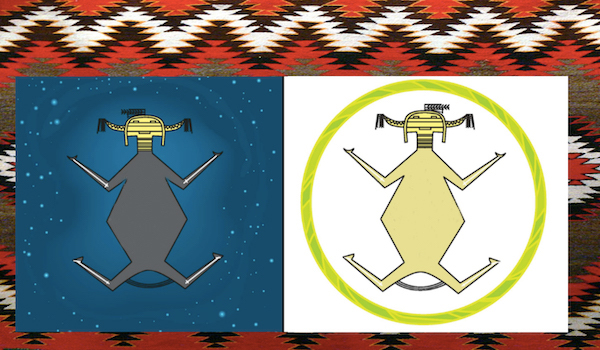
Lesson Summary
- Learn about Diné /Navajo storytelling.
- Participate in a reader’s theatre based on a Diné /Navajo tale.
- Connect the story to social and emotional skills.
Lesson Plan and Procedure
Lesson Key Facts
- Grade(s): 3, 4, 5, 6, 7, 8, 9, 10, 11, 12
- Subject(s): Drama, English Language Arts, Social Studies, Native American, Tribe Approved
- Duration of lesson: Two sessions, 40-45 minutes long
- Author(s): Brenda Whitehorse, Haley Anderson, Emily Soderborg, and Jamey A. Lowrey
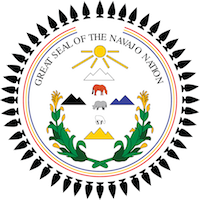
The Navajo Nation’s Department of Diné Education selected this lesson content in answer to the question, “What would you like the students of Utah to know about you?” The Department of Diné Education is the education arm of the Navajo Nation. Brenda Whitehorse, the Heritage Language Director for the San Juan School District, was selected to help craft the lesson to provide expertise, accuracy, and authenticity. It was reviewed in depth by the Navajo Nation Department of Diné Education’s Office of Diné School Improvement and Office of Standards, Curriculum, and Assessment. The lesson received approval for publication with the tribal seal by the 2022 Navajo Nation Board of Education which approval was signed by the Navajo Nation President, Buu Nygren.
Before teaching this lesson, please explain to your students that there are many Native tribes in the United States and that this lesson specifically focuses on the Navajo Nation and does not represent other Native American groups. We hope other Native tribes will respect the Navajo Nation's choice to share this aspect of their culture.
Session One: Diné Background
Before teaching this lesson, spend the time necessary to become familiar with the resources included with this lesson. We will use the words Navajo and Diné interchangeably. Navajo is the common name, but members of the tribe continue to call themselves Diné (pronounced di-NEH).
The following links provide excellent sound pronunciation as well as succinct information about the two words.
https://navajowotd.com/word/dineh/
https://americanindian.si.edu/nk360/navajo/long-walk/long-walk.cshtml
Open the book Father Sky and Mother Earth to share with your students.
You may use the slideshow presentation OR use the written pages below to teach this lesson, according to your preferences. Each will allow you to cover all the lesson material included in session one.
Warm-Up/Hook
Teacher: We are going to play a warm-up game called, “Who Started the Motion?” The whole class will stand in a circle. Then I will select one person to be the guesser. The guesser will then leave the room. While the guesser is gone, I will select one person to be the leader and will whisper a keyword to the leader, who will then begin making motions that resemble this keyword [see bullets below for words]. There are no right or wrong interpretations of the keyword. Then the rest of you in the circle will copy the leader’s motions. If the leader changes the motion, everyone changes as well. Then I will invite the guesser back into the room. The guesser will then stand in the middle of the circle, trying to figure out who the leader is. The guesser will have 3 total guesses. If the guesser cannot determine the leader, I will reveal the leader. Then I will select new people to be the guesser and the leader. We will play a few different rounds. I will give a different keyword to each leader.
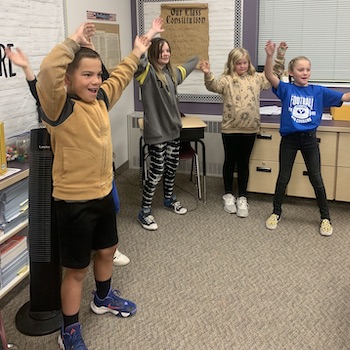
Gather the class in a standing circle. Select the guesser and have him/her leave the room. Select a leader and whisper to
him/her one of the following keywords:
- Light
- Water
- Cloud
- Bird
- Plant
Play a minimum of 3 rounds. If time, play the game 5 times so that each keyword is used.
Reflection
Address each of the types of participants by asking questions such as the following:
- Guessers, what was your experience like? How did you try and determine who was leading and not just following? Was it easier or harder than you thought it would be?
- Followers in the circle, what was your experience like? How did you discreetly and directly follow all of the motions without giving away the leader’s identity?
- Leaders, what was your experience like? How did you lead the class without giving away your identity as the leader?
Teacher: What is a lesson that we can learn from this game?
Possible student answers might be that leaders and followers must work together and support one another to make the game work, so that the leader is not too easy to spot. Everyone must be looking at one another and copying the motions, not simply staring directly at the leader. And the leader must be patient, subtle, and easy to follow.
Teacher: When we work together everyone appears to be both leader and follower. This is teamwork. Balance. Order. Unity. Leaders, tell the class the keyword you were given. What might these words have to do with unity?
Introduction
Teacher: There is a Diné story told within the Navajo Nation called “Father Sky and Mother Earth.” It has characters such as Light, Water, Cloud, Bird, and Plants. Keep these characters and the theme of unity and working together in mind as we learn more about this story and the Diné people.
Teacher: The Navajo call themselves Diné , which means “the people.”
Listen to the pronunciation as a class.
Teacher: We also refer to them as Navajo because that is the name given to them by Spanish settlers in the 1600s. We will use both terms interchangeably. The Diné live on land in between the four sacred mountains, called Diné Bikéyah (di-NEH bi-KEH-uh). The Navajo reservation, found in sections of northeastern Arizona, southeastern Utah, and northwestern New Mexico, occupies only part of this area between the four sacred mountains. It is the largest reservation in the United States, about the size of West Virginia. The Navajo Nation has the largest Native population in the United States with almost 400,000 enrolled members and over 165,000 living on the reservation itself.
Show a map of the Navajo Nation to give students context.
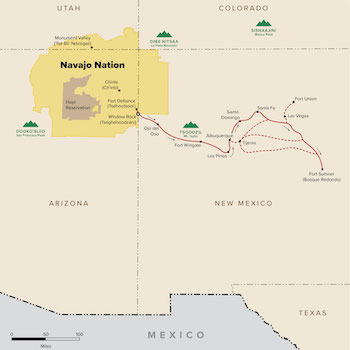
Teacher: In 1868, a treaty was signed between the Diné and the federal government to establish a sovereign nation known as the Navajo Nation. This gave the Navajo people the rights to self-governance and established government to government relations with the United States. Today the Navajo Nation continues to self-govern by operating their own schools, health care systems, and economy. The Navajo continue to preserve their rights to exercise and express their traditional ways. One way they do this is through storytelling.
Teacher: Many Navajo stories and songs teach lessons about living in harmony with your surroundings and how to walk in hó zhǫ́ (pronunciation). The Dine’ hó zhǫ́ belief system is the end goal for each person. Hó zhǫ́ is the process of developing spiritual, emotional, physical, social, and mental strength to get beyond fears and be able to have joy, happiness, confidence, and peace. Giving and receiving are a part of the balance strived for. As Navajo elders share wisdom found in the stories, listeners receive a greater understanding of themselves. Elders within the Navajo Nation are regarded with the greatest respect.
Note: This video featuring Navajo knowledge keeper, Wally Brown, Walk in Beauty (play to 1:20) explains “hó zhǫ́” in more detail. Consider sharing a portion of the video with students.
Teacher: Diné storytelling happens in specific seasons. The winter storytelling season is designated by the moon cycle from the new moon in December until the new moon in February. The commencement of haigo bahané (winter Diné stories and coyote stories) also signals that the insects and reptiles, as well as some birds and animals, have hidden away beneath the earth for hibernation. Telling stories is important because the stories contain real-life lessons in addition to teaching traditional beliefs.
Teacher: Boarding school education established in the 1890s was used to “assimilate” and “acculturate" Navajo youth into American culture by forcing them to abandon all aspects of their native culture—including their Native language. Because of this, it was challenging for youth to remember their culture. But some students would secretly gather at night to tell the stories and sing in their native Diné language. The stories were a way of passing down culture and helping Diné youth understand and respect their heritage even as others were trying to take that culture away. This system of boarding schools has been around for over 100 years, and some are still in operation. Presently, traditional storytelling is continued as a way to pass down the Diné language to the next generation. The Dine’ believe that language is a way of keeping culture alive. The Navajo language is one of the hardest languages to learn. Learning through stories helps students remember. Through time, the Diné have shared their history through speaking instead of writing. It is important that we share these stories through our voices as well. We will need to learn to correctly pronounce a few Navajo words that will be used in the story of “Father Sky and Mother Earth” that we will be experiencing today.
Listen to the pronunciations of the following words and have students practice saying these words so they will be able to pronounce them correctly when these words appear in the reader’s theatre script.
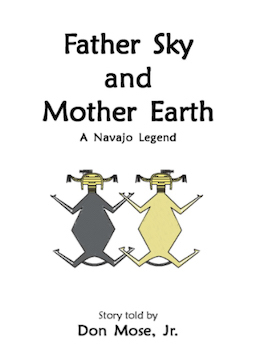
Read through the book, Father Sky and Mother Earth as a class.
Discussion
Have a discussion helping students to reflect on the story using the following possible questions:
- What were your favorite parts of the story, “Father Sky and Mother Earth?”
- What are some of the real-life lessons you thought were being taught in this story?
- What examples were shared through the characters’ actions?
- What do you think were some short-term consequences, both positive and negative, of the decisions the characters made in “Father Sky and Mother Earth?”
- What were some of the long term positive and negative consequences of the decisions that were made?
- What did we learn about demonstrating ways of working together to lead, walking in the process of hó zhǫ́, treating others respectfully, and creating balance?
Session Two: Reader’s Theatre for “Father Earth ad Mother Sky”
Make a copy of the reader’s theatre script, “Father Sky and Mother Earth” for each student before beginning this lesson.
Gather and prepare the instruments needed for the sound crew, adjust as needed for the number of students in your class.
Note: In an effort to help discourage cultural appropriation or stereotyping, we recommend that teachers have students identify the characters portrayed by wearing the picture cards included and avoiding costumes altogether.
You may use the slideshow presentation and/or use the written pages below to teach this lesson, according to your preferences. Each will allow you to present the lesson material included in session two.
Review the pronunciations of the following words and have students practice saying these words so they will be able to pronounce them correctly when these words appear in the reader’s theatre script.
Instruction/Rehearsal
Teacher: Now that we have learned more about the Diné and their storytelling, we are going to explore the Navajo tale of “Father Sky and Mother Earth” through a class reader’s theatre.
Reader’s theatre scripts are simpler than a play because you don’t memorize your parts; you read from your script. There are many variations within types of reader’s theatre scripts. This particular reader’s theatre script adds a sound crew to emphasize actions, emotions, names or other elements within the script. Like most reader’s theatres, storytellers (narrators) cue the actions or dialogue to move the script forward. Let’s look at our script today and see what you notice.
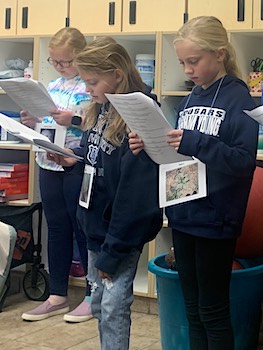
Hand out scripts to the class. Give them time to look through the script and ask students to pay
attention to what they notice.
Teacher: As you looked through the script, did you see the cast list on the first page? There are thirteen speaking roles and seven sound crew who play sounds to accompany many of the speaking roles. No matter which part you have, whether speaking or playing an instrument, you
will need to track the script carefully, listen intently, and respond at the correct time.
You may want to consider doing an initial read through before assigning parts to help students get an overview of the story.
Note: If you would like more information on how to facilitate a reader’s theatre, see “The Greedy Porcupine” lesson.
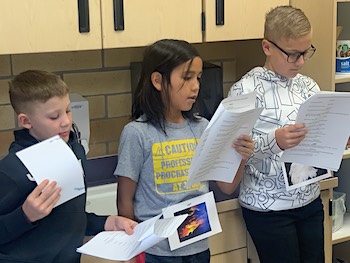
Activity/Performance
Assign parts to all students. Once roles have been assigned, have students highlight their lines to be ready to practice with the class.
Review the Diné pronunciation and go through other possibly challenging vocabulary.
Perform the reader’s theatre as a class. Additional rehearsing to lead to an informance is also a possibility.
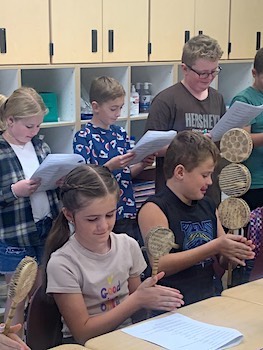
An informance is an informal (and informing) performance or exhibition created by students that focuses on process--thus is educational, entertaining, and casual. It is intended to showcase students' academic progress in the arts. An informance might involve a grade-level or individual class performing for another grade-level or class, or a class performing for their parents during school hours, or a small group performance within a single classroom.
(http://www.advancingartsleadership.com/node/67)
Discussion
Hold a class discussion. Here are some questions for discussion:
- What were some of your favorite parts of participating in this reader’s theatre?
- How was the experience of working together to share the story in a theatrical way different from just reading the story aloud?
- What new lessons did you discover that are shared through the telling of this story?
- What other stories from your own culture might be fun to write and present in a reader’s theatre format? Why would you choose that story?
Listen to students’ responses and help them clarify and reflect on their thinking, helping them to “dig deeper” using critical thinking strategies.
Assessment
Use any of the following assessments created by Jamey A. Lowrey--Senior Education Specialist, DODE–ODSI, to check student comprehension.
- Father Sky and Mother Earth: Beginning, Middle, and End of the Story
- Father Sky and Mother Earth: Multiple Choice Assessment
- Father Sky and Mother Earth: Short Answer Assessment
- Father Sky and Mother Earth: Diné Vocabulary
Extensions
Look at specific aspects of the story and have students develop a model to describe interactions between Earth’s systems including the geosphere (Mother Earth), biosphere (all living plants and animals), hydrosphere (water on earth or in the sky), and/or atmosphere (could possibly be equated with Father Sky). All the spheres in the system interconnect and overlap. No sphere works on its own. While emphasizing interactions between only two systems at a time, look for examples found in scenes from the story of two spheres interacting (for example, the rainstorm in the desert.)
- Geosphere=the solid earth
- Biosphere=all living things in, on, and around earth
- Hydrosphere=all the water in, on, and around earth
- Atmosphere=the layer of gas that surrounds Earth
Use the assessment created by Jamey A. Lowrey--Senior Education Specialist, DODE–ODSI, to check student’s science vocabulary comprehension.
- Father Sky and Mother Earth: Science Vocabulary
Learning Objectives
- Experience aspects of Navajo culture.
- Understand how stories can be used to teach lessons.
- Participate in a reader’s theatre.
- Read with sufficient accuracy and fluency to support comprehension.
Utah State Board of Education Standards
This lesson can be used to meet standards in many grades and subject areas. We will highlight one grade’s standards to give an example of application.
Grade 5 Drama
- Standard 5.T.CR.4: Define roles, identify responsibilities, and participate in group decision making.
- Standard 5.T.CR.5: Create character through physical movement, gesture, sound and/or speech and facial expression with age appropriate outcomes.
- Standard 5.T.CR.7: Recognize that participating in the rehearsal process is necessary to refine and revise.
- Standard 5.T.P.5: Communicate meaning using the voice through volume, pitch, tone, rate, and clarity.
- Standard 5.T.CO.2: Read plays and stories from a variety of cultures and historical periods and identify the characters, setting, plot, theme, and conflict to better understand performance and design choices.
- Standard 5.T.CO.3: Investigate universal or common social issues and express them through a drama/theatre work.
Grade 5 English Language Arts
- Standard 5.R.6: Determine the theme or main idea of a text including those from diverse cultures and how it is conveyed through particular details and summarize the text. (RL & RI)
- Standard 5.R.4: Read grade-level text* with accuracy and fluency to support comprehension. (RL & RI)
Grade 5 Social Studies
- Standard 5.1.1: Cite examples to illustrate how the physical geography of North America (for example, landforms, seasons, weather, bodies of water) influenced the lives of Native American tribal groups.
- Standard 5.1.2: Identify ideas, innovations, and contributions of Native Americans that have had a lasting impact on human civilization (for example, agriculture, respect for the earth and environment, inventions, fashion, art, government, language, medicines, ritual and ceremony).
- Standard 5.4.3: Summarize the impacts of forced relocation and assimilation on Native American people and how they have preserved their communities in the face of such adversity.
Grade 5 Health Education
- Standard 5.HF.2: Describe how the positive and negative consequences of a decision can have short and/or long-term effects.
- Standard 5.HF.4: Demonstrate ways to express gratitude and treat others with dignity and respect.
Grade 5 Science with Engineering Education (SEEd)
- Standard 5.1.4: Develop a model to describe interactions between Earth’s systems including the geosphere, biosphere, hydrosphere, and/or atmosphere. Emphasize interactions between only two systems at a time. Examples could include the influence of a rainstorm in a desert, waves on a shoreline, or mountains on clouds.
Diné Standards
This lesson can be used to meet many Diné standards. The following are examples of application.
4th-6th Diné Character Building Standards
- Standard: K’ é hwiinidzin dóó ádáhozdílzin bee hadínísht’ée dooleełígíí bóhwiideesh’ ááł.
I will develop and apply critical thinking to establish relationships with the environment.- Concept 2- Ádáhozdílzin.
I will maintain the sacredness of self-identity.- PO 1. Íínísts’ ą́ą’go binahjį’ bínashidi’neeztą́’ígíí choosh’į́į dooleeł.
I will listen to and apply Diné teachings. - PO 2. Hódzą’go íínánígíí bee nitséskeesgo naashá a dooleeł.
I will develop wise things in my personal life.
- PO 1. Íínísts’ ą́ą’go binahjį’ bínashidi’neeztą́’ígíí choosh’į́į dooleeł.
- Concept 3- Ádił nishdlį́į dooleeł.
I will have self-respect.- PO 2. Bił da’í í ní shta’í gí í baa jiinishba’ dooleeł.
I will show respect to my peers. - PO 3. Bił da’ííní shta’ígíí bich’į shá áhwiińt’į́į dooleeł.
I will cooperate with my peers.
- PO 2. Bił da’í í ní shta’í gí í baa jiinishba’ dooleeł.
- Concept 2- Ádáhozdílzin.
4th-6th Diné Culture Standards
- Standard: K’é dóó nitsáhákees dóó nahat’á náásgóó iiná bee siih hasingo ádoolnííł.
I will develop an understanding of Diné way of life.- Concept 2: Nahat’á
Nahat’á bits’ą́ą́dóó anootį́łígíí bik’ehgo ánísht’ée dooleeł.
I will apply and practice the Diné way of life through planning.- PO 1: Nahasdzáán dóó Yádiłhił bee nashidi’neestą́’ígíí baa náháshne’ dooleeł.
I will retell my cultural teaching of earth and sky. - PO 3. Nílch’I ał’aan ánáá’níłígíí baa hane’ yíísínísts’ą́ą’go shił bééhózin dooleeł.
I will listen to and retell stories related to elements of nature.
- PO 1: Nahasdzáán dóó Yádiłhił bee nashidi’neestą́’ígíí baa náháshne’ dooleeł.
- Concept 2: Nahat’á
4th-6th Diné Oral Language Standards
- Standard: Diné bizaad dóó bibee’ool’įįł choosh’į́įgo íísínísts’ą́ą́’ dóó bee yáshti’go saad bik’i’diishtįįh dooleeł.
Utilizing the Navajo language and culture, I will listen, communicate, observe, and understand appropriately.- Concept 1: Nitsáhakees
Íísínísts’ą́ą’go Diné bizaad bik’i’diishtįįh dooleeł.
I will listen to and understand the basic Diné language.- PO 3: Hane’ bik’i’diitáníhíí beesh’į́į dooleeł.
I will demonstrate my comprehension by acting out a story.
- PO 3: Hane’ bik’i’diitáníhíí beesh’į́į dooleeł.
- Concept 3: Iiná
Hane’ bóhooł’ą́ígíí baa hashne’ dooleeł.
I will utilize the Diné language to present information in a variety of situations.- PO 2: Hane’ áshłaayígíí bik’eh áásht’įįłgo baa hashné dooleeł.
I will use appropriate facial expressions, gestures, or dramatize to support my presentation.
- PO 2: Hane’ áshłaayígíí bik’eh áásht’įįłgo baa hashné dooleeł.
- Concept 1: Nitsáhakees
Equipment and Materials Needed
- Father Sky and Mother Earth: a Native American Literacy Program Project Booklet
- Slide presentation Father Sky and Mother Earth: Session 1 created by Yvette May (optional)
- Slide presentation Father Sky and Mother Earth--Reader's Theatre: Session 2 created by Yvette May (optional)
- One copy for each student of the reader’s theatre script: Father Sky and Mother Earth
- Classroom instruments for the sound crew. (These are merely suggestions. Use any seven instruments you have available.)
- tambourine
- drum
- triangle
- rainstick/shaker
- cymbals
- jingle bells
- claves/woodblock
- Highlighters to mark scripts
- Character sign cards/stick puppets (optional)
- Father Sky and Mother Earth Assessments created by Jamey A. Lowrey--Senior Education Specialist, DODE–ODSI
Additional Resources
This lesson was created thanks to a grant from the National Endowment for the Arts and the Utah Division of Arts & Museums.
- https://www.navajo-nsn.gov/
- https://www.navajonationdode.org/
- https://media.sjsd.org/
- https://mpc.byu.edu/education-resources
- https://eschooltoday.com/learn/interaction/#:~:text=The%20atmosphere%20provides%2 0the%20geosphere (energy)%20from%20the%20atmosphere.
- https://www.tomsofmaine.com/good-matters/thinking-sustainably/solar-system-for-kids-how-learning-about-space-benefits-earth
Image References
Image 1: “Father Sky and Mother Earth” by Molly Trainor based on sketches by Don Mose, Jr.
https://digitallibrary.utah.gov/aw-server/rest/product/purl/USL/i/1537525a-f56f-49f3-bcf8-
Image 2: Navajo Nation Department of Diné Education
Image 3: Sydney Zundel
Image 4: Curtis Soderborg
Image 5: Father Sky and Mother Earth title page, by Molly Trainor based on sketches by Don Mose, Jr. https://digitallibrary.utah.gov/aw-server/rest/product/purl/USL/i/1537525a-f56f-49f3-bcf8-ec3d1fc1d323
Images 6-8: Sydney Zundel
© Brigham Young University and Navajo Nation Department of Diné Education

www.education.byu.edu/arts/lessons
 Download
Download